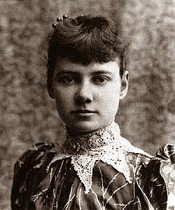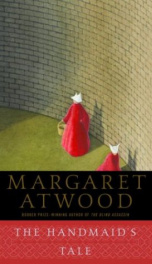Bly Nellie

Nellie Bly (May 5, 1864[1] – January 27, 1922) was a pioneer woman in journalism. She remains notable for two feats: a record-breaking trip around the world in emulation of Jules Verne, and an exposé in which she faked insanity to study a mental institution from within. In addition to her writing, she was also an industrialist and charity worker. Born Elizabeth Jane Cochran in Cochran's Mills, Armstrong County, Pennsylvania, 40 miles northeast of Pittsburgh, she was nicknamed "Pink" for wearing that color as a child. Her father, a wealthy former associate justice, died when she was six. Her mother remarried three years later, but sued for divorce when Cochran was 14. Cochran testified in court against her allegedly drunken, violent stepfather. As a teenager she changed her surname to Cochrane, apparently adding the "e" for sophistication.[2] She attended boarding school for one term, but dropped out because of a lack of funds. In 1880, Cochran and her family moved to Pittsburgh. A sexist column in the Pittsburgh Dispatch prompted her to write a fiery rebuttal to the editor, who was so impressed with her earnestness and spirit he asked her to join the paper. Female newspaper writers at that time customarily used pen names, and for Cochran the editor chose "Nellie Bly", a misspelling of the title character in the popular song "Nelly Bly" by Stephen Foster. Bly focused her early work for the Dispatch on the plight of working women, writing a series of investigative articles on female factory workers. But editorial pressure pushed her to the women's pages to cover fashion, society, and gardening, the usual role for female journalists of the day. Dissatisfied with these duties, she took the initiative and traveled to Mexico to serve as a foreign correspondent. Still only 21, she spent nearly half a year reporting the lives and customs of the Mexican people; her dispatches were later published in book form as Six Months in Mexico. In one report, she protested the imprisonment of a local journalist for criticizing the Mexican government, then a dictatorship under Porfirio Díaz. When Mexican authorities learned of Bly's report, they threatened her with arrest, prompting her to leave the country. Safely home, she denounced Díaz as a tyrannical czar suppressing the Mexican people and controlling the press. Burdened again with theater and arts reporting, Bly left the Pittsburgh Dispatch in 1887 for New York City. Penniless after four months, she talked her way into the offices of Joseph Pulitzer's newspaper, the New York World, and took an undercover assignment for which she agreed to feign insanity to investigate reports of brutality and neglect at the Women's Lunatic Asylum on Blackwell's Island. After a night of practicing deranged expressions in front of a mirror, she checked into a working-class boardinghouse. She refused to go to bed, telling the boarders that she was afraid of them and that they looked crazy. They soon decided that she was crazy, and the next morning summoned the police. Taken to a courtroom, she pretended to have amnesia. The judge concluded she had been drugged. She was then examined by several doctors, who all declared her to be insane. "Positively demented," said one, "I consider it a hopeless case. She needs to be put where someone will take care of her."[3] The head of the insane pavilion at Bellevue Hospital pronounced her "undoubtedly insane". The case of the "pretty crazy girl" attracted media attention: "Who Is This Insane Girl?" asked the New York Sun. The New York Times wrote of the "mysterious waif" with the "wild, hunted look in her eyes", and her desperate cry: "I can't remember, I can't remember."[4] Committed to the asylum, Bly experienced its conditions firsthand. The food consisted of gruel broth, spoiled beef, bread that was little more than dried dough, and dirty undrinkable water. The dangerous inmates were tied together with ropes. The inmates were made to sit for much of each day on hard benches with scant protection from the cold. Waste was all around the eating places. Rats crawled all around the hospital. The bathwater was frigid, and buckets of it were poured over their heads. The nurses were obnoxious and abusive, telling the patients to shut up, and beating them if they did not. Speaking with her fellow residents, Bly was convinced that some were as sane as she was. On the effect of her experiences, she wrote: "What, excepting torture, would produce insanity quicker than this treatment? Here is a class of women sent to be cured. I would like the expert physicians who are condemning me for my action, which has proven their ability, to take a perfectly sane and healthy woman, shut her up and make her sit from 6 a.m. until 8 p.m. on straight-back benches, do not allow her to talk or move during these hours, give her no reading and let her know nothing of the world or its doings, give her bad food and harsh treatment, and see how long it will take to make her insane. Two months would make her a mental and physical wreck."[3] "...My teeth chattered and my limbs were ...numb with cold. Suddenly, I got three buckets of ice-cold water...one in my eyes, nose and mouth." After ten days, Bly was released from the asylum at The World's behest. Her report, later published in book form as Ten Days in a Mad-House, caused a sensation and brought her lasting fame. While embarrassed physicians and staff fumbled to explain how so many professionals had been fooled, a grand jury launched its own investigation into conditions at the asylum, inviting Bly to assist. The jury's report recommended the changes she had proposed, and its call for increased funds for care of the insane prompted an $850,000 increase in the budget of the Department of Public Charities and Corrections. In 1888, Nellie suggested to her editor at the New York World that she take a trip around the world, attempting to turn the fictional Around the World in Eighty Days into fact. A year later, on November 14, 1889 she left New York on her 24,899-mile journey. A train was created for the leg from San Francisco to Chicago, the Miss Nellie Bly Special. "Seventy-two days, six hours, eleven minutes and fourteen seconds after her Hoboken departure" (January 25, 1890) Nellie arrived in New York. At the time this was a world record for circling the earth, though it was bettered a few months later by George Francis Train, who completed the journey in 67 days. On her travels around the world, she went through England, France (where she met Jules Verne in Amiens), Brindisi, the Suez Canal, Colombo (Ceylon), Hong Kong, the Straits Settlement of Penang and Singapore, and Japan. In 1895 Nellie Bly married millionaire manufacturer Robert Seaman, who was 40 years her senior. She retired from journalism, and became the president of the Iron Clad Manufacturing Co., which made steel containers such as milk cans and boilers. In 1904 she invented and patented [5] the steel barrel that was the model for the 55-gallon oil drum still in widespread use in the United States. Her husband died that year. For a time she was one of the leading female industrialists in the United States, but mismanagement forced her into bankruptcy. Forced back into reporting, she covered such events as the women's suffrage convention in 1913, and stories on Europe's Eastern Front during World War I.[6] In 1916 Nellie was given a baby boy whose mother requested Nellie look after him and see that he become adopted. The child was illegitimate and difficult to place since he was half-Japanese. He spent the next six years in an orphanage run by the Church For All Nations[clarification needed] in Manhattan. As Nellie became ill towards the end of her life she requested her niece, Beatrice Brown, look after the boy and several other babies in whom she had become interested. Her interest in orphanages may have been part of her ongoing efforts to improve the social organizations of the day. She died of pneumonia at St. Mark's Hospital in New York City in 1922, at age 57, and was interred in a modest grave at Woodlawn Cemetery in the Bronx.
do you like this author?
What readers are saying
What do you think? Write your own comment on this book!
write a commentWhat readers are saying
What do you think? Write your own comment on this author!
write a commentBook list

Nellie Bly's Book
Around the World in Seventy-Two Days
Series:
Unknown
Year:
Unknown
Raiting:
4/5
Show more
add to favoritesadd In favorites

Ten Days in a Mad-house
Series:
Unknown
Year:
Unknown
Raiting:
3.5/5
Ten Days in a Mad-House is a book written by newspaper reporter Nellie Bly in 1887. The book comprised Bly's reportage for the New York World while on an undercover assignment in which she feigned insanity to investigate reports of brutality and neglect at the Women's Lunatic Asylum on Blackwell's Island. The book's graphic depiction of conditions at the asylum caused a sensation, brought Bly lasting fame and prompted a grand jury to launch its own investigation, with Bly assisting. The jury's report resulted in an $850,000 increase in the budget of the Department of Public Charities and Corrections.
Show more
add to favoritesadd In favorites

Nellie Bly's Book
Series:
Unknown
Year:
Unknown
Raiting:
1/5
This is a true story of lady reporter Nellie Bly's race around the world in an attempted to match fictional journey in the Jules Verne book -Around the world in Eighty Days. Nellie Bly (May 5, 1864– January 27, 1922) was an American journalist, author, industrialist, and charity worker. She is most famous for her record-breaking trip around the world.
Show more
add to favoritesadd In favorites
Book list

Nellie Bly's Book
Around the World in Seventy-Two Days
Series:
Unknown
Year:
Unknown
Raiting:
4/5
Show more
add to favoritesadd In favorites

Ten Days in a Mad-house
Series:
Unknown
Year:
Unknown
Raiting:
3.5/5
Ten Days in a Mad-House is a book written by newspaper reporter Nellie Bly in 1887. The book comprised Bly's reportage for the New York World while on an undercover assignment in which she feigned insanity to investigate reports of brutality and neglect at the Women's Lunatic Asylum on Blackwell's Island. The book's graphic depiction of conditions at the asylum caused a sensation, brought Bly lasting fame and prompted a grand jury to launch its own investigation, with Bly assisting. The jury's report resulted in an $850,000 increase in the budget of the Department of Public Charities and Corrections.
Show more
add to favoritesadd In favorites

Nellie Bly's Book
Series:
Unknown
Year:
Unknown
Raiting:
1/5
This is a true story of lady reporter Nellie Bly's race around the world in an attempted to match fictional journey in the Jules Verne book -Around the world in Eighty Days. Nellie Bly (May 5, 1864– January 27, 1922) was an American journalist, author, industrialist, and charity worker. She is most famous for her record-breaking trip around the world.
Show more
add to favoritesadd In favorites
What readers are saying
What do you think? Write your own comment on this author!
write a commentif you like Bly Nellie try:
readers also enjoyed
What readers are saying
What do you think? Write your own comment on this author!
write a commentGenre
if you like Bly Nellie try:
readers also enjoyed
Do you want to exchange books? It’s EASY!
Get registered and find other users who want to give their favourite books to good hands!





















